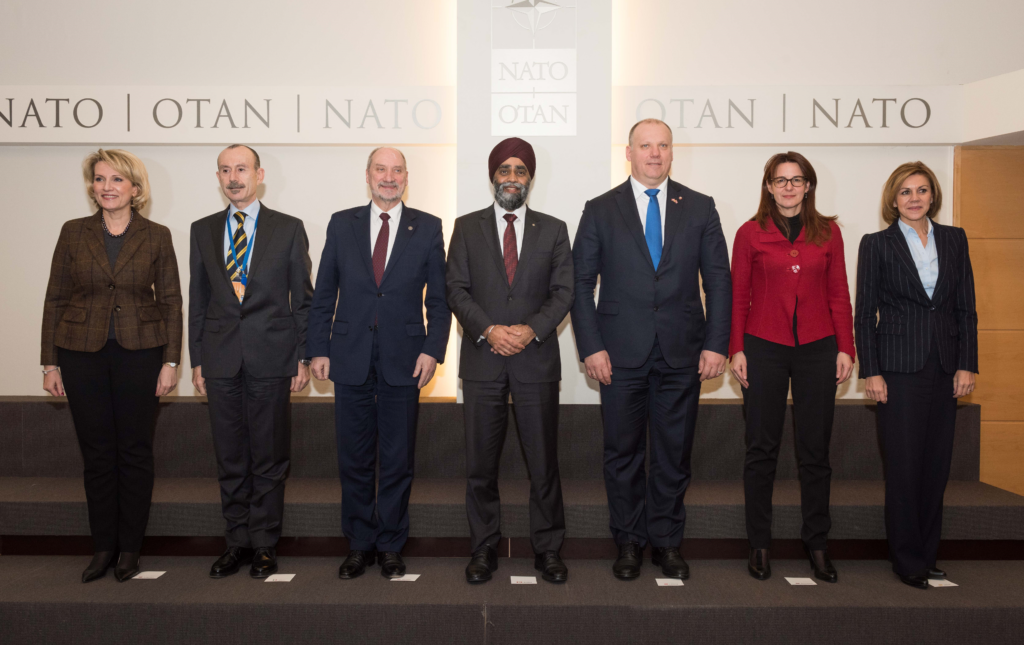 The MND with some of his NATO colleagues. The tone of his next meeting with them will be shaped by the upcoming Defence Policy. Photo: MCpl/Cplc Jennifer Kusche, DND/MDN IS06-2017-0003-014
The MND with some of his NATO colleagues. The tone of his next meeting with them will be shaped by the upcoming Defence Policy. Photo: MCpl/Cplc Jennifer Kusche, DND/MDN IS06-2017-0003-014

Brigadier General Matthew Overton (Retired) OMM MA, is the CDA Institute Research Manager and Senior Editor.
The question of investment in and maintenance of Canada’s Armed Forces is one that has been peculiar in Canada. Canada, so it seems to many Canadians, remains blessed with a distance – physical, social and societal – from much of the conflict that occurs around the globe. Untrue as it may be, this belief places at arm’s length the discussions concerning defence, armed forces and the fundamental question of what is an appropriate level of government spending to safeguard the Canadian way of life that we all enjoy and treasure.
The Standing Senate Committee on National Security and Defence has taken aim squarely at this debate, recommending that Canada move directly and with determination toward meeting the agreed-to aspiration within NATO of annual defence spending that is 2% of our Gross Domestic Product (GDP). However, the bald assertion of 2% as the sole defining measure of defence commitment has been roundly opposed by our governments. Canadians point with justification to the regular and significant participation of the Canadian Armed Forces on NATO missions as an equally valid measurement of contribution to the Alliance. It is a fair point.
But, as one of the most publicly touted measures of national commitment to the shared defence and security obligations of NATO membership and the one agreed to by the member nations, it cannot be ignored entirely. Certainly, our NATO allies will not ignore it, however sympathetic and agreeable they may be to Canadian reminders of our steady support for NATO operations in comparison to some of their own efforts. Canada must deal with this reality. As CDA Institute Fellow Chuck Davies reminded us last year, other possible measures also show that Canada spends less on defence, comparatively, than most of our closest and most ‘like-minded/like-situated’ allies:
|
Country |
Regular Force | Defence Budget | Percentage of GDP |
Spending per Capita in $CA |
Spending per Regular Force Member in $CA |
| France | 215,000 | €46.9B | 1.9 | $927.69 | $322,200 |
| United Kingdom | 149,000 | £45.1B | 2.0 | $1,160,30 | $576,380 |
| Australia | 58,000 | $AS 32.0B | 1.8 | $1,321.50 | $522,000 |
| United States | 1,430,000 | $US 597.5B | 3.3 | $2,456.70 | $522,100 |
| Canada | 68,000 | $CA 20.0B | 0.9 | $527.28 | $294,120 |
Source: http://cdainstitute.ca/wp-content/uploads/Davies_Analysis_March_2016.pdf
Time moves on; Australia for example has continued to evolve it’s thinking on defence, resulting in increases to their defence spending plans, which are now forecast to reach the 2% level by 2021.
The Senate Committee recommends meeting the 2% aspirational goal by 2028 and this would mean progressive defence expenditure increases reaching an annual defence budget of $55.4 billion dollars by that year. Effectively, this would mean a tripling of the defence budget in 11 years, if the GDP projections are valid. It is an ambitious plan and would require a concerted effort of collective political and national will to achieve, as well as considerable effort and focus to ensure that those monies were effectively and efficiently used – another subject of discussion and recommendations by the Committee.
It is important to recall however, where we are now and to put this into perspective for the upcoming Defence Policy and the spending that will be proposed to implement it. Current defence spending, which successive Governments have regularly agreed is insufficient to meet Canada’s defence requirements – for purely national defence purposes and then to act with effect on the continent and globally – is currently $18.6b. Charitably, this is 1% of Canada’s GDP. Maintaining this ratio to GDP would still result in a rise in the defence budget to approximately $26.9b by 2028, or about 1.5 times the current budget. This is still unlikely to address the underfunding that the MND has recently highlighted and hard to represent as a ‘significant’ investment programme that he has hinted will accompany the Defence Policy when it is announced.
Without doubt, the most important aspect of the Defence Policy must remain the objectives and effects that Canada wishes to achieve for Canadians, Canada and our place in the world. These are objectives and effects that meet the needs of Canada – as reaffirmed by the MND – rather than some external, arbitrary standard or set of criteria.
The defence budget, the practical statement of the government’s intent to attain these objectives and effects will be a key measure of their commitment to making real the Policy they have tabled. The ‘significant’ investment noted by the MND must necessarily require a budget commitment for long-term funding more significant than $26.9b by 2028 – we already know that this is not adequate for even the defence results currently expected, let alone those for the future.
The question then, is “how much more, and why?”. Canadians, in Parliament and across the country, must know these answers – and support them – for that moment when our allies ask these questions of us, and even more importantly, when our men and women in uniform are committed to the important and dangerous tasks we demand of them daily.